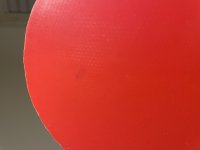This user has no status.
This user has no status.
Well-Known Member
Think about corkscrew as the way a football is thrown. A good spiral on a football makes it fly straight. Corkscrew would be that spin and with that spin the ball would not hook. It would fly straight and you would only see the sidespin after the bounce and the bounce would be a surprising kick to the side. The reason, on that shot, that the kick to the side would be surprising is, the ball would have been flying straight. Also, a corkscrew spin would not cause the ball to arc down towards the table. So if it was corkscrew, most of my loops would go long and they would not allow me the big angles I get on them because they would not drop near the net when I want them to.
The axis of the spin on my loop is a pretty simple side top. But it would be cool as hell to be able to get a corkscrew spin off a forehand topspin stroke. But to get that spin your racket would actually have to be moving sideways over or under the ball: forward momentum on the stroke would prevent the corkscrew spin from occurring.
Okay, now instead of throwing a foot ball, think of it as trying to bend a soccer ball on a free kick.
When you want it to bend downward and to the left you would hit the top,right side of the ball.
This causes the ball to bend in mid air but as well kick forward a bit when it hits the ground.
We know that there are two types of sidespins, one where the table tennis ball is spinning on an x axis and one where it's spinning on the Z-axis (corkspin).
I can't however get the ball to completely spin on one of these axis and not the other when attempting to do sidespin. My trajectory is a mix of both. More of a diagonal between the two.
I believe every shot has a mix of SOME top/backspin (y-axis), SOME left or right bend in the air (x-axis), and SOME kick to a side when it hits the table (Z-axis)
Do you notice that when you aim at someone near their backhand it kicks to their forehand and catches them off guard on some of your loops?
This happened to me a couple times against you, it could have just been the sidespin being less gradual as it got closer to me and becoming more extreme and me misjudging where it would end up. However, I believe you actually have a bit of corkspin that you may not know about on your hook.
I'm enjoying this topic.
Edit: imagine a ball moving forward with a completely left diagonal topspin halfway between the Z and y axis.
The balls initial movement will be straight but will curve to the left because of the sidespin. If we could get this 50% sidespin to be 25% instead, then the ball would have 75% topspin which would make it drop more drastically but curve to the left less.
In this situation we reduced the amount of spin that was spinning along the x axis and moved that spin to the y axis. However we reduced nothing along the Z axis and it still has the corkspin and will still get that extra side kick from hitting the table.
Sent from my iPhone using Tapatalk
Last edited:











